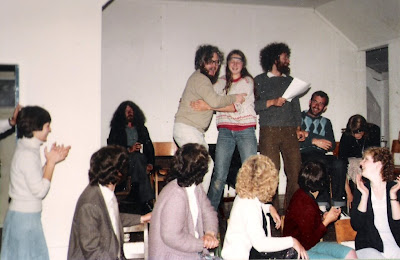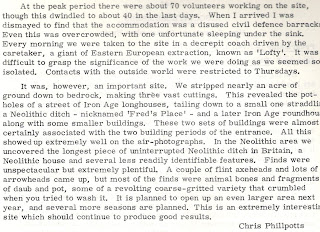Saturday, February 28, 2009
That horse's head again ...
Friday, February 27, 2009
Planning from 1985
Thursday, February 26, 2009
Ullenwood: the kitchen sink
Wednesday, February 25, 2009
Planning perspective
Tuesday, February 24, 2009
Have Crickley Hill Man's early morning habits been rumbled?
Monday, February 23, 2009
The Bandstand in Montpelier Gardens
Sunday, February 22, 2009
Personality of the Year 1982
Saturday, February 21, 2009
The 1983 to 1985 entry in the Transactions of BGAS
Friday, February 20, 2009
Jim Irvine's 1979 portrait of Mike Taylor
Thursday, February 19, 2009
Beautiful view of Crickley
Wednesday, February 18, 2009
Savage 1988, 4: The First Farmers
My thanks to Richard Savage and the Crickley Hill Trust for permission to reproduce these abstracts from his 1988 booklet.
"Neolithic Villagers c. 4000 to 2500 BC
The first farming communities, "Neolithic" or "new Stone Age", whose cutting tools were stone and flint, reached Britain from the continent in the centuries about 4000 BC, bringing with them forerunners of plants and animals whose management still supports us now: wheat, barley, cattle, sheep, and pigs. They also brought the manufacture of pottery, from this time the archaeologists most consistent guide to cultural change and affinity. They represented a way of life, with origins in the Near East six millennia earlier or more, which totally changed man's relationship with his environment.
A hunter-gatherer community will probably move with the seasons as its resources change, and over-exploits them at its peril. Its numbers must always be small. A farming community on the other hand must be static in the medium term to protect its growing crops and granaries, and well stored grain will remain in good condition for long enough to feed it through the year. Domestic animals efficiently convert grass, foliage and other rough vegetable matter to human use. In the longer term, while there is new land to farm, ill-management or even an increase in population can be tolerated.
The methods of these first farmers, which were efficient, will have been at their most effective of the light well-drained soils, either of the uplands - as at Crickley - or of the parts of the valleys lying on sand or gravel. In
[Illustration: Neolithic Axe E. J. P. Wilczynska]
[Illustration: The Neolithic ditch was quarried with antler picks R. Bryant]
It seems likely - not yet quite certain - that this enclosure defended a settlement on the highest part of the hill, for the Neolithic finds of flint and pottery are most due densely clustered there. A second bank and palisade, quarried from deeper ditches, was later added about 30 m inside it, to defend the same central area. The original outer defence had at least five entrances, three to the east to the west where the tip of the promontory runs down to the Vale, and four of these were now matched by entrances through the inner defences. Post holes suggest that all the entrances had wooden gates, and in through the southeastern entrants led a straight, fenced roadway with at least one rectangular wooden house beside it. This was at the edge of the settlement, in the natural hollows some 50 m from the dense finds scatter which marks the centre of Neolithic occupation. We can recognize this as a house because it stands in bedrock eroded to small particles in which large post holes were easily dug, and preserved by silt washing down into the hollow. The bedrock at the centre of occupation is stone, and the soil deposits are very thin; the shapes of individual houses are here much harder to make out.
[Illustration: Conjectural reconstruction of the first Neolithic village. The positions of the central houses are not yet known. C. Clark]
The inner and outer defences were demolished, with deliberate burning, and their stone was used to refill the quarry pits. The stone was later in part extracted and the banks were rebuilt. This process was repeated a number of times, and finds of arrowheads suggest that several times the defences were attacked by bowmen. The sequence of methodical destruction and rebuilding is hard to account for on strictly practical grounds, though it is common among sites of this kind, the "causewayed" or "interrupted-ditch" enclosures, of which over 40 are known in the Neolithic of south
[Illustration:
Before 2500 BC the site was abandoned. The pits of the outer defence had been refilled, and not re-dug, sometime before; now the inner one, too, was left filled, and silted up.
Tuesday, February 17, 2009
The bailing gang 1980
Monday, February 16, 2009
Captain Lash - instalment 2
Sunday, February 15, 2009
Mr Crickley 1982 ...
V A Wright: The Cotswolds, Crickley Hill, Birdlip, Gloucestershire
Saturday, February 14, 2009
Going, going, nearly gone ...
Welcome to Kate Cole, Bess and Daisy
A charming portrait from the Barter studio ...
Friday, February 13, 2009
Dr Ferris has some questions ...
Thursday, February 12, 2009
Mercy mission ...
Ferris, I.M. reflects upon life and flint ...
Wednesday, February 11, 2009
Look behind you, Ros!
Phillpotts on Lash ...
Tuesday, February 10, 2009
Dr Phillpotts's earliest published work ...
Monday, February 9, 2009
Hula Hoop woman writes ...
I happened to drive down the Leckhampton Road a couple of weeks ago. I noticed that Threshers - scene of many a Crickley Hill booze run - is still going strong. There has also been a new addition to the road - a rather insalubrious establishment called "Bargain Booze" - which presumably, if it had been there c.1980, would have been the off-licence of choice for hard up diggers.
I was in Cheltenham for the funeral of my aunt, who was the reason why I came to Crickley in the first place. I figured that I could always disappear off to her flat for a bath and a decent meal on a Thursday - if conditions proved primitive (which indeed they did). A disproportionate number of Crickely-ites seemed to have relatives in Cheltenham for the same reason."






























